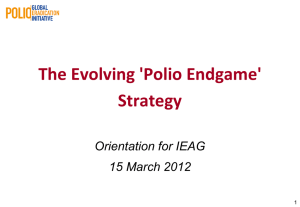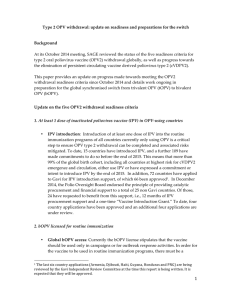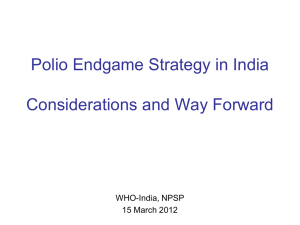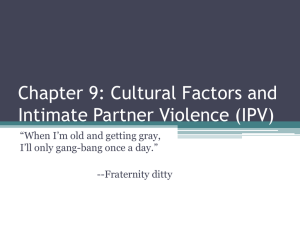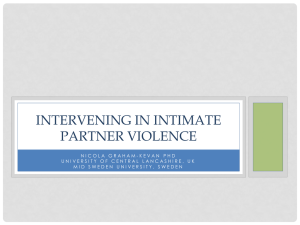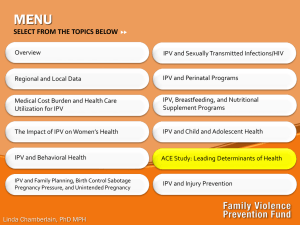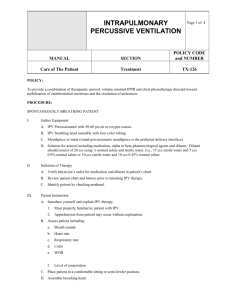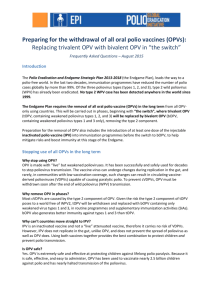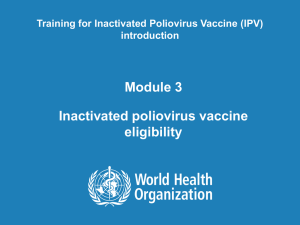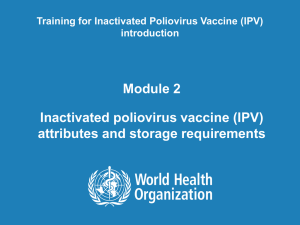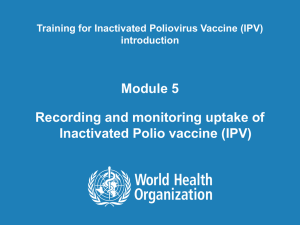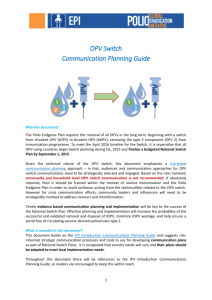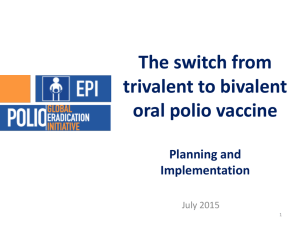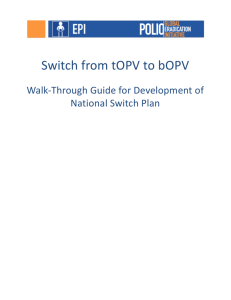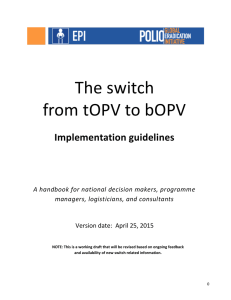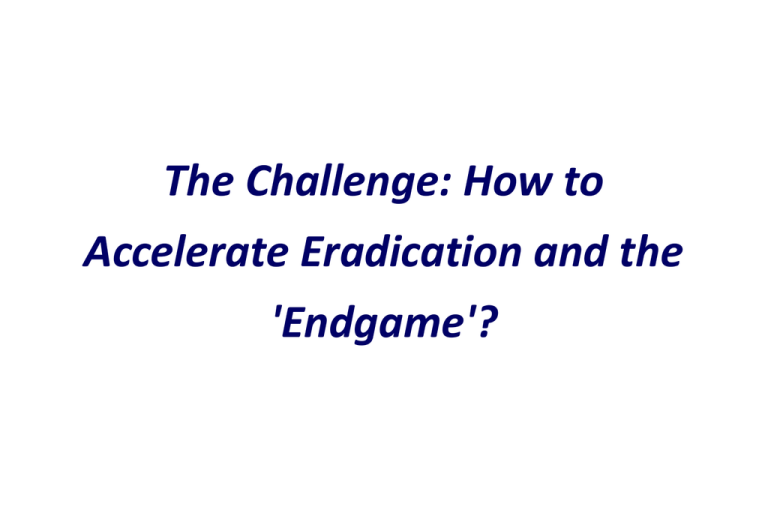
The Challenge: How to
Accelerate Eradication and the
'Endgame'?
Historical Evolution of 'Post-Eradication'
Last WPV case
Years
Global Cert
Comm (1995)
0
OPV cessation
2
4
6
8
10
12
Wild virus
Certification
eradication
Certification &
containment
The 'Polio Endgame' refers
to management of the
'post-eradication' risks due
to OPV.
Expert Advisory
Meeting (1998)
Wild virus
eradication
ACPE (2004)
Wild virus
eradication
Certification &
containment
VDPV elimination?
World Health
Assembly (2008)
Wild virus
eradication
Certification &
containment
VDPV elimination &
validation
Post-OPV
surveillance
VDPV: Vaccine-derived poliovirus ACPE: Advisory Committee for Polio Eradication
2
New polio endgame: Guiding principles
•
phased removal of Sabin viruses, beginning with
highest-risk (type 2).
•
elimination of VDPV type 2 in parallel with
eradication of last wild polioviruses by switching
from tOPV to bOPV for routine EPI & campaigns.
•
early introduction of IPV, at least in high risk areas
for VDPVs, to provide type 2 protection.
3
A new 'Endgame' strategy: parallel instead of
sequential risk management
Last wild polio case
Years
Sequential risk
management
Parallel risk
management
0
Wild virus
eradication
Wild virus
eradication
trivalent OPV cessation
2
Certification &
containment
6
8
VDPV elimination &
validation
10
12
Post-OPV
surveillance
Certification &
containment
VDPV2 elimination &
validation
earlier IPV introduction &
OPV2 cessation
4
Post-OPV
surveillance
bivalent OPV 1&3
(bOPV) cessation
4
Implications
•
First: Early universal IPV introduction (priority
highest cVDPV risk areas) integrated into routine
immunization program (before switch).
•
Second: Switch from tOPV to bOPV in a globally
synchronized manner. Switch date as early as April
2013.
•
Third: For outbreak control, use IPV, mOPV2, or
exercise re-start tOPV option
5
Product development needs
•
REQUIRED: Licensure of bOPV in all self-producing
countries.
•
REQUIRED: Appropriate presentations and labelling
change to permit use of fractional-dose IPV (1/5 of
full dose).
•
OPTIONAL: Availability of appropriate jet injectors
for intradermal administration.
6
Expanded Use of bOPV
Bivalent OPV efficacy & use
Seroconversion after 2 x bOPV
vs. tOPV, India, 2008-2009
bivalent OPV use
as of Sept 2011
100
90
80
79.5
71
70
60
53.2
49.1
50
40
30
20
10
Introduced
Dec 09-Aug 11
0
bOPV
tOPV
Type 1
bOPV
tOPV
Planned by
end-2011
Type 3
8
Urgent bOPV priorities
•
Licensure of bOPV in self-producing countries: Brazil,
China, Iran, Mexico, Russian Federation, Serbia,
Vietnam, ... .
•
Regulatory approach: Reproduce licensing strategy
that led to approval of six manufacturers.
•
Label-change of current bOPV: Current bOPV
licensed only for supplemental doses, not for
primary immunization.
9
bOPV data needs
•
Clinical trial: bOPV administered in four-dose
schedule ('EPI schedule'), with doses administered at
0, 6, 10, and 14 weeks.
•
Modelling: Risk of cVDPV2 emergence, assessment
of risk mitigation strategies.
•
Mucosal immunity: Will bOPV induce type 2 mucosal
immunity after IPV.
10
Fractional-dose IPV
Background: Countries with IPV Use
Standalone IPV
IPV - penta combo
IPV - hexa combo
Unknown
Not applicable
Data in WHO HQ as of Sep 2010
The boundaries and names shown and the designations used on this map do not imply the expression
of any opinion whatsoever on the part of the World Health Organization concerning the legal status of
any country, territory, city or area or of its authorities, or concerning the delimitation of its frontiers or
boundaries. Dotted lines on maps represent approximate border lines for which there may not yet be
full agreement.
WHO 2010. All rights reserved
Affordable IPV Strategy: Approaches
Reduce number
of doses
Reduce amount
of dose
Reduce antigen
content
Reduce
production cost
• Use fewer doses per schedule
• Develop intradermal (ID) device or microneedle patch to stretch doses
• Use adjuvant to reduce antigen contents per
dose
• Enables IPV production in developing countries
with less or non-infectious strain
IPV priorities
•
Product required: one- or two dose IPV presentation.
•
Regulatory approval: label-change to include
intradermal administration.
•
Policy decisions: (1) fractional-dose IPV as supplemental
dose(s) to current OPV schedule in routine
immunization programs (either with DTP3 at 16 wks or
with measles at 9 mos); and (2) fractional-dose IPV in
supplemental immunization campaigns (SIAs).
14
Feasibility of Approach: Oman, GSK IPV at 2, 4,
and 6 mos, Biojector2000®
Poliovirus type 1
seroconversion, %
[median titer]‡
Poliovirus type 2
seroconversion, %
[median titer]‡
Poliovirus type 3
seroconversion, %
[median titer]‡
ID
n=187
IM
n=186
P values
97.3%
100%
NS
228
95.7%
724
100%
<0.001
0.01
287
97.9%
1149
100%
<0.001
NS
362
>1448
<0.001
Mohammed AJ, et al. N Engl J Med 2010;362:2351-9.
Single-dose Immunogenicity: Cuba, NVI IPV
at 4 (and 8) mos, Biojector2000®
Preliminary Results
P2
P1
Study design
Randomized controlled trial
Field work in Camaguey Province, Cuba
IPV from Netherlands Vaccine Institute
Enrolling 160 infants per arm
Serum at 4m, 8m, 8m+7d and 8m+30d
IPV at 4- and 8 m fractional vs full-dose
Seroconversion (single and two-dose)
Priming (8m and 8m+7d)
P3
100%
90%
80%
70%
60%
50%
40%
30%
20%
10%
0%
ID
IM
1st dose
ID
Priming
IM
2nd dose
ID
Not immune
IM
IPV data needs
•
Clinical trial: non-inferiority of a fractional versus fulldose IPV (given with pentavalent vaccine at 14 wks
and/or with measles vaccine at 9 mos)
•
co-administration assessment (immunogenicity of
different antigens, including hepatitis B)
•
large scale-safety assessment
•
Immunology: Assessment of priming (difference from
seroconversion); duration of effect
•
Modelling: Geographic phasing, number of doses, full
versus factional dose IPV, outbreak control options
17
Intradermal needle-free devices
Needle-free device priorities
• Product(s)
required: intradermal device
appropriate for developing countries (i.e., springpowered).
• Regulatory
approval: WHO-prequalification.
• Policy
decision: use device to administer
fractional-dose IPV in supplemental
immunization campaigns (SIAs).
19
New Needle-free Intradermal-only Devices
Bioject
Device data needs
•
Comparative evaluation: assessment of appropriate
intradermal devices– immunogenicity, reactogenicity,
ergonomics [planned in Cuba in 2012].
•
Clinical trial: non-inferiority study of supplemental
full-dose (by needle & syringe) or fractional-dose IPV
(by needle-free device and needle & syringe)
[planned in India for 2012].
21
Upcoming Consultations on new Endgame Strategy
• Spearheading partners+ (19 October)
• Polio Donor Contact Group (20 October)
• OPV/IPV Manufacturers (27 October)
• WHO's Scientific Advisory Body of Experts (SAGE) (10 Nov)
• Expert Consultation on VDPVs (January/February 2012)
• WHA Executive Board (January 2012)
• World Health Assembly (May 2012)
22
Summary
•
a new definition of, and strategy for, the 'endgame' could
accelerate eradication & reduce long-term risks.
•
depending on IPV price and strategy, the new endgame
could be cost-neutral through certification.
•
a number of workstreams would be needed to address
major unresolved questions/risks (policy, R&D, vaccine
supply, surveillance/validation, operations, financing).
23

